December Garden Priorities for your Los Angeles Regenerative Garden
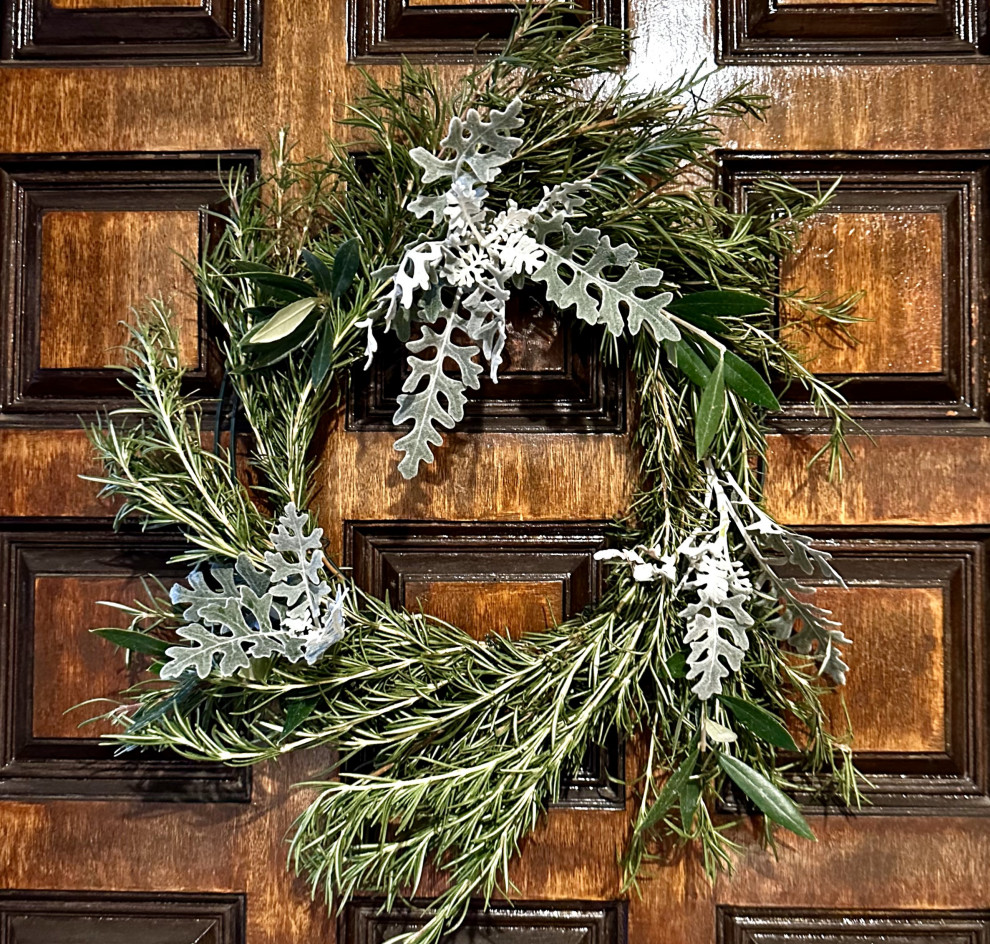
Sara’s homemade wreath made of rosemary and dusty miller clippings
Regenerative Coastal California Gardening Guide
By Mandy Staal
California Certified Nursery Professional, California Naturalist, Certified California Native Plant Landscaper
Weather and Climate
La Niña is on her way to LA. The NOAA states there are equal chances of above, below, or average precipitation for our region and higher chances of warmer temperatures. La Niña is very unpredictable. Let’s hope we get some rain so we can capture it!
Blooms, Color, and Pollinators
Pollinator-friendly garden design in Long Beach and San Pedro
The hummingbirds have been very active lately and the Anna’s hummingbirds should be nesting at this time. Many birds are eagerly awaiting ripe toyon berries. These winter bloomers splash the garden with color:
- manzanitas
- toyon, flowers and red berries
- fuchsia flowered gooseberry
- chaparral currant
- snowberry
- coffeeberry
- yarrow
- aloe
- mountain marigold
Harvests
Edible gardens in San Pedro, Long Beach, Torrance and Palos Verdes
These plants may be ready for harvest in your garden depending on when you planted:
- broccoli
- beets, carrots, kohlrabi, turnips
- peas
- celery
- lettuce
- various herbs
Now is still a great time to plant cool season herb starts like parsley and cilantro, you can also still sow cilantro seeds for a quick crop before the warm season returns. If you don’t have your holiday season’s herbs growing in your kitchen window or potted on your patio, with the holiday festivities here it is a great time to reduce plastic waste by growing your own thyme, rosemary, sage, marjoram and oregano. These are also great companions for your leafy greens in the veg garden to ward off pests. We have recently even seen peacocks avoiding garden beds heavily planted with aromatics such as onion and herbs. If you have not already planted garlic heads, do it now! While they won’t be as large as if they were planted around Halloween, they are still one of the easiest and most rewarding things to plant. For more details about growing garlic in Edible gardens in San Pedro, Long Beach, Torrance and Palos Verdes (zone 10) check out this article from San Diego Seed Company
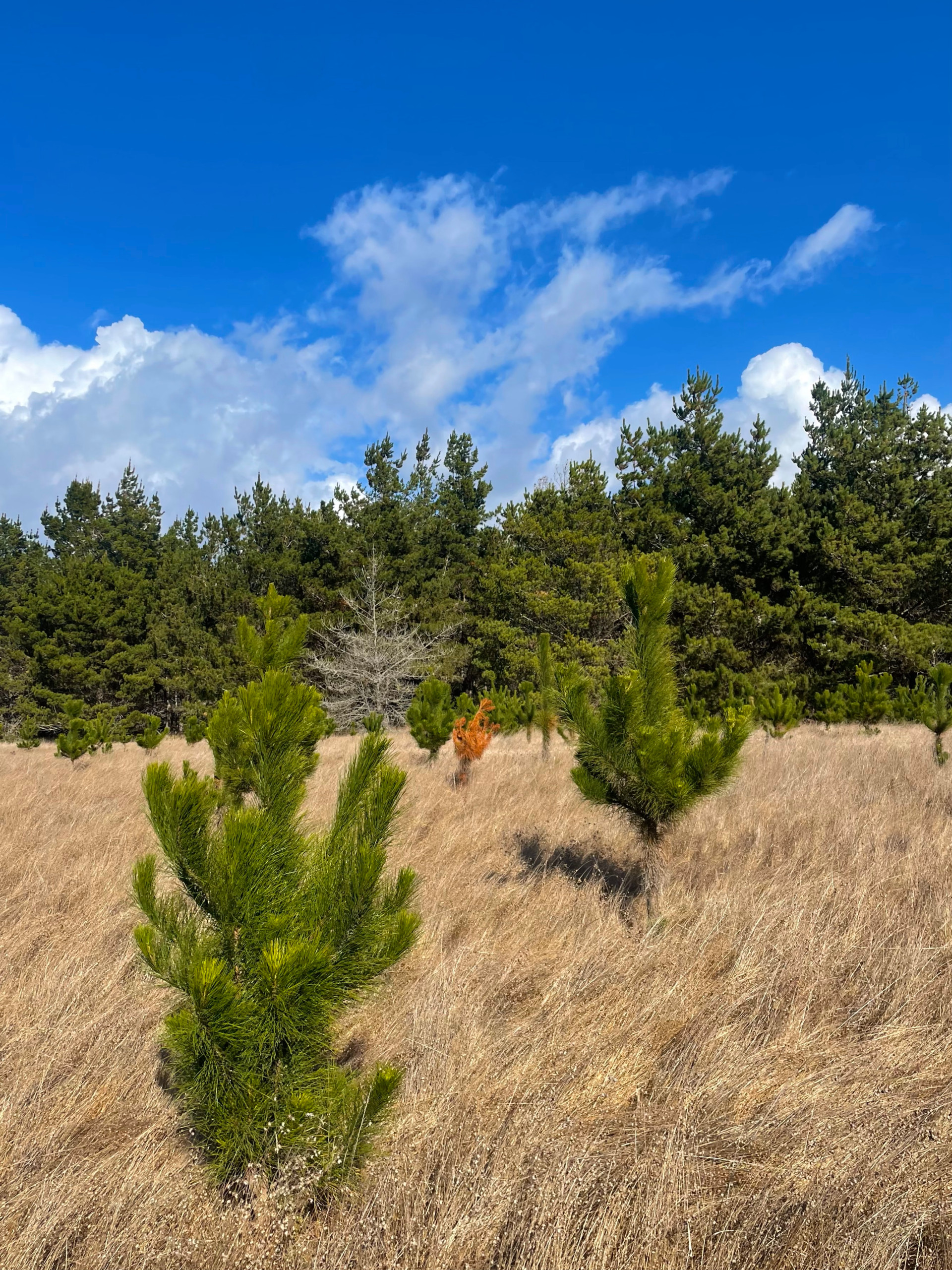
Monterey Pines at the Fiscalini Preserve in Cambria
Planting
California native plant gardens in Torrance, San Pedro, and Palos Verdes Peninsula
- For native seed starting, sow acorns, iris, toyon and, of course, wildflowers. Get a pack of native wildflower seeds from Tree of Life Nursery, Plant Material, Artemisia Nursery, or Theodore Payne Nursery. You can usually find California poppy seeds at most local nurseries too.
- Mix your wildflower seeds with your native soil and a bit of water in a container before broadcasting to reduce birds nibbling on them. Or you can lightly rake them into the soil.
- You can continue to plant in the rainy season to develop robust root systems that will lead to thriving, lush plants in the spring. Just don't disturb the soil until a few days after a good rain. It can lead to compaction if the soil is too moist.
- Divide actively growing perennials like rush, iris, and sedges.
- Plant bulbs for spring blooms
- Cool season veggies can continue to be planted
Watering
Waterwise garden design San Pedro, Long Beach, Torrance and Palos Verdes
With cool temperatures and anticipated rain, most plants don’t need frequent water. Be sure to adjust irrigation to be even less frequent, if you haven’t already.
- Set your irrigation to manual once the rain starts so precious water is not wasted.
- In an established native garden (1 year or older), there’s no need for supplemental irrigation if it has rained more than 1.5” that month.
- Fruit trees appreciate a deep soak weekly to biweekly depending on your soil and how much fruit is on the tree.
- Raised beds and pots with new plantings prefer water every other day. Those with more established plants prefer water twice a week.
Keep in mind these estimates are highly variable according to plant needs, soil, sun, wind, etc. If you are in doubt about your watering schedule and amount, check the soil moisture at least 4 inches deep for trees and shrubs and 2 inches deep for annuals.
Pruning
Many plants love to be pruned this month to make room for fresh, lush growth in the spring. Make use of your evergreen pruning scraps like rosemary and turn them into a festive wreath!
- Make sure you sanitize pruners with alcohol between different plants to prevent spreading diseases.
- It is a great time to prune your natives except for winter or early spring bloomers like toyon, ceanothus and manzanita.
- It is especially important to cut back Matilija poppies and other herbaceous perennials this month
- You can prune your deciduous fruit trees this month but this task can definitely wait till after the holidays. Only prune them once their leaves have dropped. For more information regarding care for your trees post winter pruning, especially related to dormant sprays and disease prevention we recommend reading this article by Greg Alder.
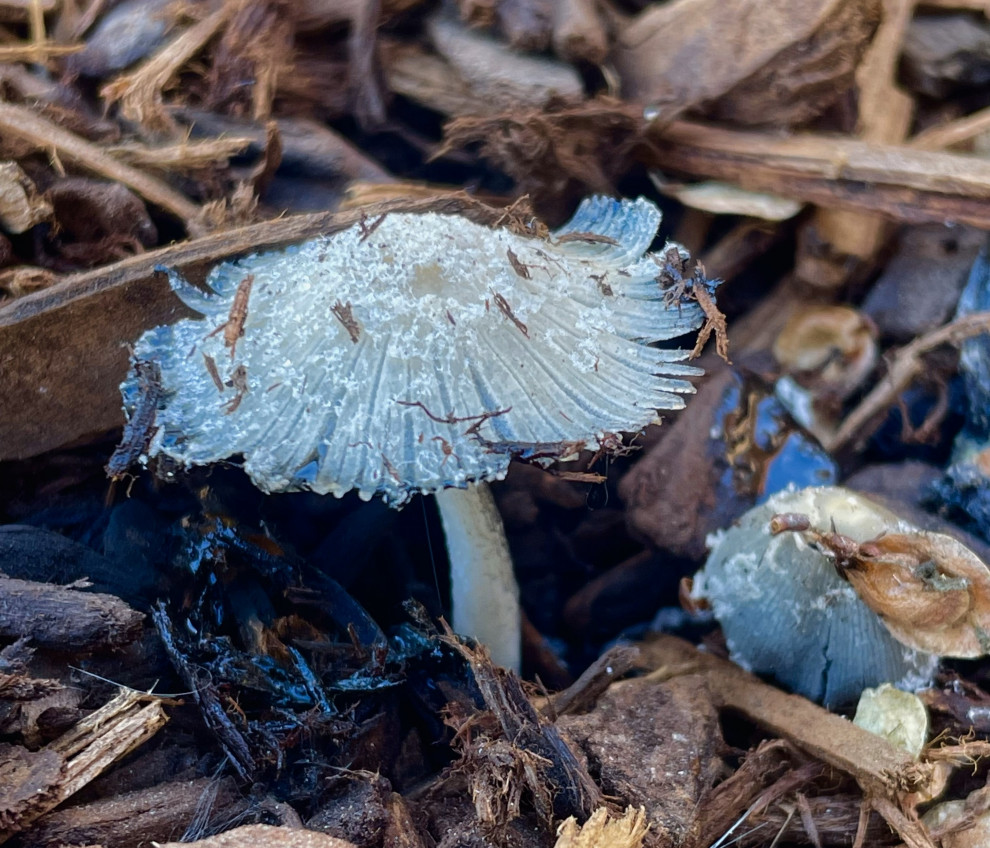
Mushrooms popping up from a thick layer of mulch
Fertilizing
There is not much need for fertilizing when most plants aren’t actively growing. We don’t need to apply excess fertilizer that may get washed into our watersheds by the rain. That being said, for your veggies and herbs you can continue adding compost or an organic fertilizer made from food scraps without any synthetic additives (such as Dr. Earth brand) every 4-6 weeks for improved yield.
Mulching and Compost
- Add compost and mulch if you haven’t already in fall to improve soil quality. They will start breaking down nicely with the rain. These organic materials feed soil organisms like earthworms and fungi which then help feed plants. You may even get some cute mushrooms sprouting up post-rain!
- Make sure the crown (where the trunk meets soil and tapers) of trees and shrubs is not buried in mulch or compost as this can cause rot.
- Leave the leaves! No need to rid plants of their natural mulch with leaf blowers.
- Adding acidic planting mix to acid loving plants like berries, azaleas, and camellias will help them stay healthy and green through the winter. If you have pine needles, oak leaves, and/or coffee grounds available, these can alternatively be applied around acid loving plants (in moderation!) as a natural method to begin to improve acidity in soil.
Pests and Diseases
- Gophers are more active when the soil is moist. If you have gophers in your area, protect your transplants’ roots with chicken wire or gopher baskets when you plant. Luckily many native plants are not the gophers’ favorites.
- Keep an eye out for wilting or diseased plants. Powdery mildew or downy mildew may be culprits this time of year.
- This is best treated by removing diseased leaves. (Copper fungicides which are often recommended may be necessary in extreme cases, but we generally recommend avoiding in habitat gardens as these types of sprays can be detrimental to birds, bees and other critters, especially when sprayed near blooms or during feeding times of day.)
- To decrease risk of disease, thin branches to allow good circulation and air to flow through, reducing moisture sitting on leaves. Sanitize your pruners with alcohol pray in between cuts to prevent spreading infection.
- Make sure your spray irrigation isn’t going off too late in the afternoon as this can allow moisture to sit on leaves too long and activate disease overnight. Ensure plants have optimal time to dry out during the day and between watering events where possible.
- Remember near the coast, mildew is part of life. While it can be an ugly nuisance, it usually won’t kill the plant when dealt with aggressively through the measures detailed above.
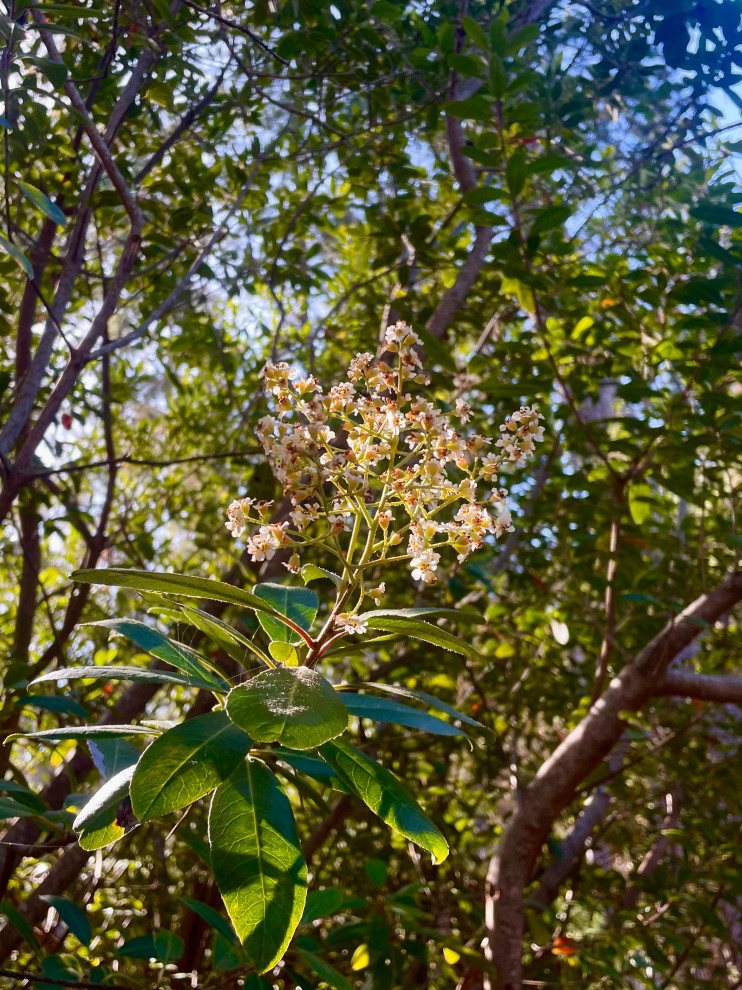
Blooms of toyon
Gratitude
by Sara Saxonberg
The team at Pachamama Inspired would like to take a moment to thank YOU this holiday season. Thank you for reading and your continued support!! Please share with us any thoughts or recommendations for future newsletters so we can best serve you.
I personally would also like to take this moment to recognize the magnificent consultant team at Pachamama Inspired. Thank you, Mandy, for sharing your expertise in this beautiful newsletter. Thank you to our multitalented consultants who make ALL of our work possible in so many ways: Gina, Leila, Ruth, Kaylie, Michelle, Grace and Johanna thank you for all your invaluable contributions to our mission this year.
Thank you especially to our AMAZING clients with whom this business would not exist! We are so grateful for your ongoing trust and commitment to creating beautiful regenerative spaces around Los Angeles and Orange county.
I would also personally like to thank my beloved family who’s continued support has kept me going through so many trials and tribulations this past year.
Last but most importantly I would like to take a moment to recognize and offer our sincerest gratitude to the land, Pachamama, for all she provides. From shade to food to beauty to diversity, the land beneath our feet continues to share her abundance and teachings with us and all creatures.
With the business of the holiday season, we hope you can take a moment and get outside and reserve special time to enjoy the natural world. While you are convening, remember to offer your thanks and gratitude to Pachamama. Thankfully She doesn’t demand too much of us during this chaotic time of year. A small offering of fragrant herbs or tobacco, some beautiful blooms or seeds can all go a long way to acknowledge your thanks.
Remember that for many it can be a stressful time – taking a moment to listen to the bird song or gentle sounds of the breeze or hopefully some gentle rain can all be incredibly healing. Taking note from the natural world, remember that December is a time for renewal – a time for rest, gratitude, family, and giving.
XO - Sara
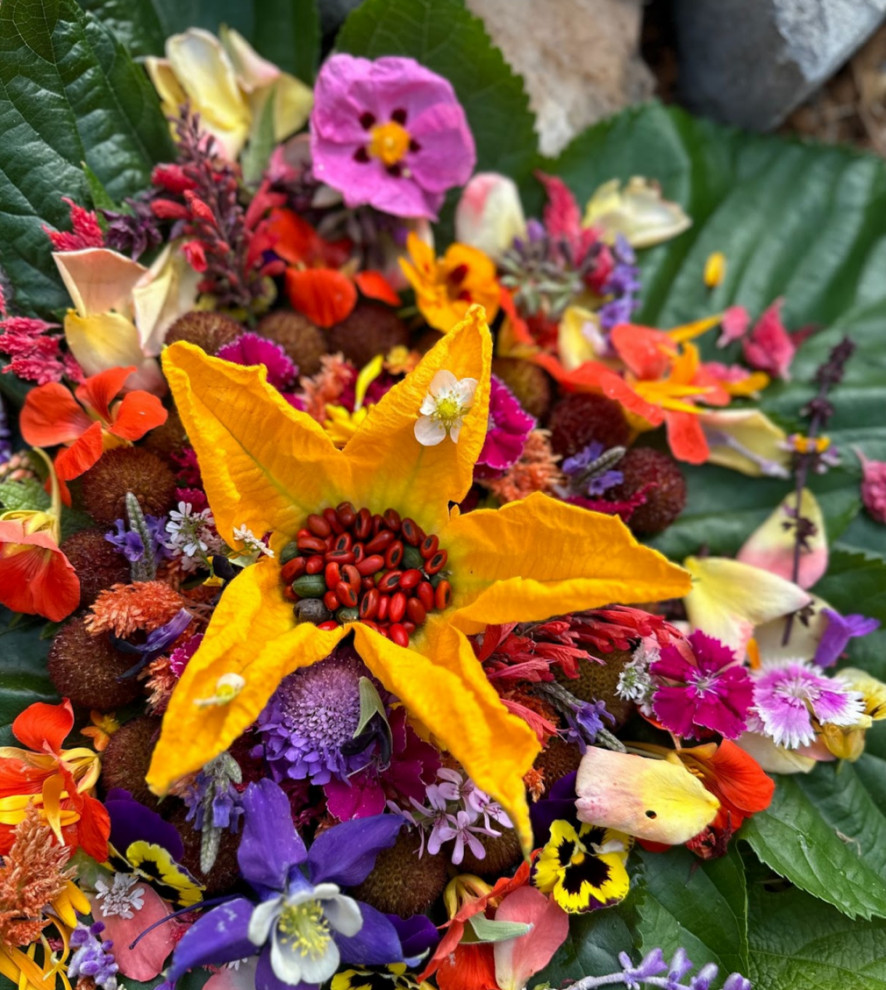
Sara's offering
Resources:
https://californianativeplants.com/blog/december2023-in-the-natural-garden/
https://www.noaa.gov/news-release/us-winter-outlook-warmer-and-drier-south-wetter-north
“California Native Gardening: A Month by Month Guide” by Helen Popper
